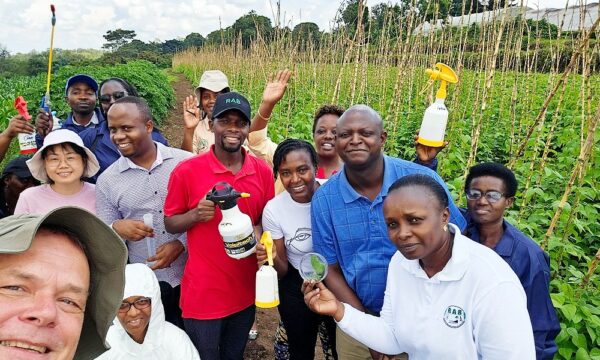In this video, scientists and local people explain the dangers of Opuntia stricta, an invasive cactus weed covering large tracts of land in Kenya’s semi-arid Laikipia County, and efforts in place to tame its spread and adverse impacts.
O. stricta, a native plant of South America, is causing problems for people, domestic animals as well as wildlife. It was introduced in Kenya as an ornamental plant but has since invaded community lands according to Arne Witt, regional coordinator for invasive species at the Center for Agriculture and Biosciences International (CABI).
In Laikipia, about 253 kilometres to the north of Nairobi, Kenya’s capital city, it is dominating thousands of hectares of land given its fast propagating nature. As a result it is reducing the area of agricultural farmlands, wildlife areas and ranches. It is also causing socioeconomic and health challenges.
But scientists are now using a bio-control method in the area to destroy the weed. They have introduced a sap-sucking bug called Dactylopius opuntiae, commonly known as cochineal. It was imported from South Africa where it is being used to control the cactus weed in Kruger National Park.
Bio-control is restoring the ecosystem’s natural balance and curbing the weed’s spread, Witt explains. The cochineal specifically feeds on the cactus and has gone through laboratory tests to ensure it has no non-target impacts, especially on other plants.
Since the introduction of cochineal in the Laikipia areas of II Polei, Naibunga and Dol Dol, infected plants have virtually stopped producing fruit, inhibiting further spread of this noxious weed. This is more so where communities have embraced the use of cochineal, according to Witt.
O. stricta cannot be suppressed through chemical and mechanical control because of the costs associated with those methods. The spread of the cactus in Laikipia, Witt explains, is fuelled by the fact that it adapts well to semi-arid regions.
He says bio-control is a long-term, sustainable and effective way of controlling widespread invasive species in Africa. “Embracing bio-control in Africa, not only for controlling invasive plants but also for controlling crop pests is crucial as pests become resistant to chemicals over time,” says Witt. “Over 200 weeds species [are] resistant to herbicides, 500 weed species are resistant to chemicals.”
A survey has shown that O. stricta spread is getting worse, but Witt is optimistic that in four to five years cochineal will get established.
Invasive species is a growing concern in Kenya — 50 per cent of such plants are introduced intentionally into the country for ornamental or agro-forestry purposes.
“Invasive species [are] foreign species brought from somewhere else as a result of human activities, and once established in a new environment, their proliferation starts to have a negative impact on diversity, crop production and animal health,’’ Witt says.
He adds, “We need a strict surveillance in place such that any new invasive [species] can be detected very early and eradicated.”
Kimani Kuria, manager of the community development programme at Ol Jogi Game Reserve, says science is playing a big role in biological control. “When harvested, the plants stay in the green house for two months laced with cochineal”, he says, adding that using the green house is improves the control and speed of the process.
The impact of O. stricta extends to wildlife and livestock. When abandoned baby elephants are rescued, Kuria explains, their tongues are found to be septic as a result of damage from the plant, and they cannot feed well. He says this is also seen in livestock in neighbouring communities, as the majority depend on livestock production. “If we do not manage Opuntia stricta, we will lose millions of dollars in range land production and livestock production in Kenya.’’
Kuria explains that the cactus has a waxy layer on the leaves, which means that a high concentration of chemical or other methods are required to control it, which would pose a threat to non-target organisms.
This article was originally published on SciDev.Net. Read the original article
Related News & Blogs
Biological control in action: Zambia’s field days on fighting fall armyworm
Experts from CABI recently held two field days and an expo in Zambia, showcasing innovative approaches to pest management to 584 farmers, agro-dealers and other stakeholders to help raise awareness of approaches to tackle the invasive fall armyworm (Sp…
11 June 2025





